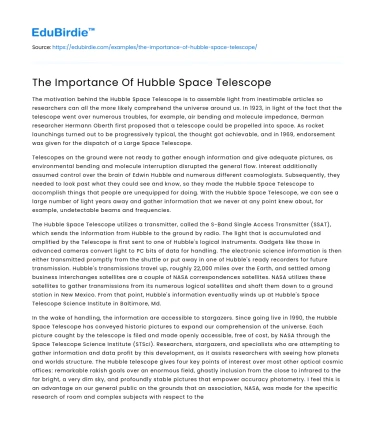The motivation behind the Hubble Space Telescope is to assemble light from inestimable articles so researchers can all the more likely comprehend the universe around us. In 1923, in light of the fact that the telescope went over numerous troubles, for example, air bending and molecule impedance, German researcher Hermann Oberth first proposed that a telescope could be propelled into space. As rocket launchings turned out to be progressively typical, the thought got achievable, and in 1969, endorsement was given for the dispatch of a Large Space Telescope.
Telescopes on the ground were not ready to gather enough information and give adequate pictures, as environmental bending and molecule interruption disrupted the general flow. Interest additionally assumed control over the brain of Edwin Hubble and numerous different cosmologists. Subsequently, they needed to look past what they could see and know, so they made the Hubble Space Telescope to accomplish things that people are unequipped for doing. With the Hubble Space Telescope, we can see a large number of light years away and gather information that we never at any point knew about, for example, undetectable beams and frequencies.
Save your time!
We can take care of your essay
- Proper editing and formatting
- Free revision, title page, and bibliography
- Flexible prices and money-back guarantee
The Hubble Space Telescope utilizes a transmitter, called the S-Band Single Access Transmitter (SSAT), which sends the information from Hubble to the ground by radio. The light that is accumulated and amplified by the Telescope is first sent to one of Hubble's logical instruments. Gadgets like those in advanced cameras convert light to PC bits of data for handling. The electronic science information is then either transmitted promptly from the shuttle or put away in one of Hubble's ready recorders for future transmission. Hubble's transmissions travel up, roughly 22,000 miles over the Earth, and settled among business interchanges satellites are a couple of NASA correspondences satellites. NASA utilizes these satellites to gather transmissions from its numerous logical satellites and shaft them down to a ground station in New Mexico. From that point, Hubble's information eventually winds up at Hubble's Space Telescope Science Institute in Baltimore, Md.
In the wake of handling, the information are accessible to stargazers. Since going live in 1990, the Hubble Space Telescope has conveyed historic pictures to expand our comprehension of the universe. Each picture caught by the telescope is filed and made openly accessible, free of cost, by NASA through the Space Telescope Science Institute (STScI). Researchers, stargazers, and specialists who are attempting to gather information and data profit by this development, as it assists researchers with seeing how planets and worlds structure. The Hubble telescope gives four key points of interest over most other optical cosmic offices: remarkable rakish goals over an enormous field, ghastly inclusion from the close to infrared to the far bright, a very dim sky, and profoundly stable pictures that empower accuracy photometry. I feel this is an advantage on our general public on the grounds that an association, NASA, was made for the specific research of room and complex subjects with respect to the obscure. Inside the association, they use numerous instruments, one of which is the Hubble Space Telescope. With the development of the Hubble Space Telescope, specialists, stargazers, researchers, and even common residents, can collect information and utilize that to fulfill their interest and need to get proficient about such a mind-boggling and baffling point.






 Stuck on your essay?
Stuck on your essay?

